AQUASTAT - FAO's Global Information System on Water and Agriculture
FAO Reports
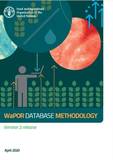
WaPOR database methodology - Version 2 release
WaPOR database methodology - Version 2 release
WaPOR Version 2 was launched in June 2019 based on extensive internal and external validation and quality assessment. This report describes the methodology used to produce the different data components of WaPOR Version 2 at the 250m (Level 1), 100m (Level 2) and 30m (Level 3) resolution, as made available through WaPOR version 2.0 release.

WaPOR quality assessment - Technical report on the data quality of the WaPOR FAO database version 1.0
This report is the result of an independent quality assessment of the different datasets as available in the FAO's data portal to monitor Water Productivity through Open access of Remotely sensed derived data (WaPOR 1.0). The quality assessment checks the consistency of the different layers and compares the individual layers to various other independent data sources, including: spatial data; auxiliary data and in-situ data.

Water accounting and auditing. A sourcebook
Water Report 43 - 2017; (french)
In many regions of the world, sustainable and reliable delivery of water services has become increasingly complex and problematic. Complexities that are very likely to increase, considering the unprecedented confluence of pressures linked to demographic, economic, dietary trends, and climate change. The rationale behind this water accounting and auditing sourcebook is that scope exists worldwide to improve water-related sectoral and inter-sectoral decision-making at local, regional and national levels. This sourcebook aims to provide practical advice on the application and use of water accounting and auditing, helping users planning and implementing processes that best fit their needs.
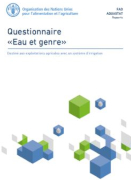
Questionnaire "Water and gender". Intended for agricultural holdings with an irrigation system
AQUASTAT Report 2016 (french)
This questionnaire is an edited version of the original questionnaire used within the framework of the pilot project "The role of women in agricultural water management - Phase 1" (page 127-139). Changes have been made, because the objective of the original version was to concentrate on interviewing women - heads of agricultural holdings or family labour (wives or daughters) - only, based in Algeria, Morocco and Tunisia. This present edited version is useful to interview both women and men and also in multiple countries.

The role of women in agricultural water management - Phase 2. Mainstreaming gender in data on agricultural water management
AQUASTAT Report 2016 (french)
This paper presents the results of a follow-up project in Algeria and Tunisia on the development of gender-sensitive indicators related to the role of women in agricultural water management. The paper summarizes the results of the "Phase 1" project, then presents the results of two studies conducted in Algeria and Tunisia on institutional level actors dealing with agricultural water management and national-level sex-disaggregated data. Most importantly, the paper reflects on the efforts to mainstream gender in statistics relative to agricultural water management, the limitations in collecting this data and finally offers various recommendations to reduce the gaps related to gender in water statistics.

Evaporation from artificial lakes and reservoirs
Dams and their associated reservoirs provide many services. However, these artificial lakes and reservoirs evaporate more water than the natural surface water flow before the dam was built, because dams generally increase the surface area of the body of water. This means that more water is exposed to air and direct sunlight, thus increasing evaporation. This "lost" water is referred to as consumed, because it is removed from the system. Due to its importance in some cases, AQUASTAT has estimated the evaporation for all artificial lakes and reservoirs that are available in its geo-referenced dams database. This exercise is a very rough estimation, with many limitations, and it thus should be considered as an 'order of magnitude' study only.
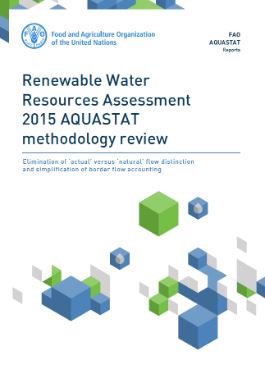
Renewable Water Resources Assessment - 2015 AQUASTAT methodology review
One of the first products developed by AQUASTAT, since its start in 1994, has been the water resources assessment methodology. Even though very useful, during the 20 years that AQUASTAT has been using this methodology it appeared that the methodology is not without shortcomings and is in some cases overcomplicated. It has become increasingly apparent that some of the main problems should be addressed. Therefore, in March 2015 AQUASTAT has implemented some changes, which are described in this note. While the proposed changes do not address all problems, they do constitute an important step forward that will allow the programme to deliver statistics with higher accuracy while simultaneously reducing the amount of unnecessary complication.
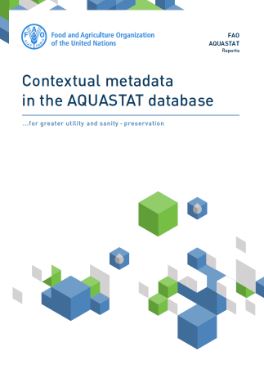
Contextual metadata in the AQUASTAT database
Within the context of the AQUASTAT database, metadata is assigned at three levels: database, concept (variable-country-year), and data-point. This document describes AQUASTAT's experience in designing and implementing a system whereby contextual qualitative information (metadata) can be applied directly to data-points. It describes the metadata concept, provides examples, and shows how the system has been implemented in the AQUASTAT database. The target audience for this document is other data owners and/or data managers that might be interested in adding structure to their notes.
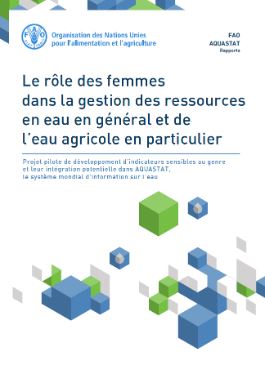
The role of women in agricultural water management - Phase 1. Results of a pilot project to develop gender-sensitive indicators
AQUASTAT Report 2014 (french)
This Working Paper describes the result of a pilot project in Algeria, Morocco and Tunisia on the development of gender-sensitive indicators related to the role of women in agricultural water management. The study shows that it was not possible to have gender-disaggregated data at national level, especially related to water and agriculture. Therefore the information gathered cannot yet be included into the AQUASTAT database, which contains national-level data. However, despite this constraint, the project certainly played an important role with regards to the reflection on gender-sensitive indicators and some proposals on gender-sensitive indicators are given in the document.

Irrigation in Central Asia in figures: AQUASTAT Survey - 2012
Water Report 39 - 2013; (russian)
This report presents the results of the most recent survey carried out in the six countries of the Central Asia region, and it analyses the changes that have occurred in the ten years since the first survey. Section I describes in detail the methodology used and contains a glossary of the terms used. Section II contains the regional analysis presenting a synopsis on water resources, water use and irrigation in the region and the trends over the last ten years. It also describes the legislative and institutional framework for water management as well as environmental issues and it presents prospects for agricultural water management from the countries’ perspective. Section III contains detailed country profiles for Afghanistan, Kazakhstan, Kyrgyzstan, Tajikistan, Turkmenistan and Uzbekistan, and one river basin profile for the Aral Sea basin.
Update of the Digital Global Map of Irrigation Areas (GMIA) to Version 5
FAO/University of Bonn Report - 2013
This report describes the update of the Digital Global Map of Irrigation Areas to version 5. For this update, the inventory of subnational irrigation statistics was updated with new information derived from national census surveys or irrigation sector studies. For the first time, the global map of irrigation areas also contains data layers on the percentage of area equipped for irrigation that is actually irrigated and on the source of irrigation water: groundwater, surface water, water from non-conventional sources.
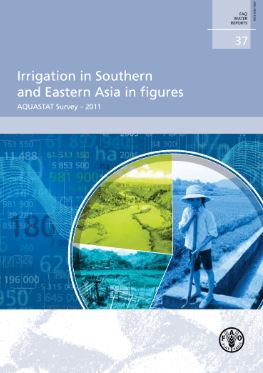
Irrigation in Southern and Eastern Asia in figures: AQUASTAT Survey - 2011
This report presents the results of the most recent survey carried out in the 22 countries of the Southern and Eastern Asia region, and it analyses the changes that have occurred in the ten years since the first survey. Section I describes in detail the methodology used. Section II contains the regional analysis which presents a synopsis on water resources development and irrigation in the region. Section III contains a more detailed description of four transboundary river basins: the Ganges-Brahmaputra-Meghna, Indus, Mekong and Salween river basins. Section IV contains the detailed profiles on the situation in each country: Bangladesh, Bhutan, Brunei Darussalam, Cambodia, China, Democratic People’s Republic of Korea, India, Indonesia, Lao People’s Democratic Republic, Malaysia, Maldives, Mongolia, Myanmar, Nepal, Pakistan, Papua New Guinea, Philippines, Republic of Korea, Sri Lanka, Thailand, Timor-Leste, Viet Nam.

Coping with water scarcity - An action framework for agriculture and food security
Water Report 38 - 2012; (french); (spanish)
FAO has recently embarked on a long-term programme on the theme "Coping with water scarcity – the role of agriculture". Based on an expert consultation, a conceptual framework has been developed to help address the question of food security under conditions of water scarcity. This report presents the conceptual framework, reviews a series of policy and technical options, and establishes a set of principles that should serve as a basis for the development of effective food security policies in response to growing water scarcity.
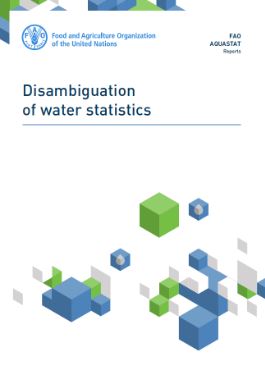
Disambiguation of water statistics
AQUASTAT Report 2010, revised 2012; (french)
The nomenclature surrounding water information is often confusing and gives rise to different interpretations and thus confusion. When discussing the way in which renewable water resources are utilized, the terms water use, usage, withdrawal, consumption, abstraction, extraction, utilization, supply and demand are often used without clearly stating what is meant. This note attempts to shed light on how the AQUASTAT programme defines these terms.
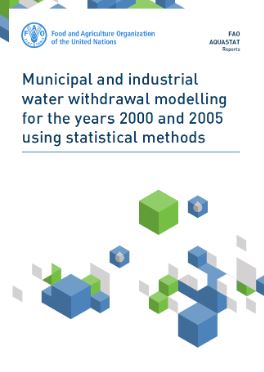
Municipal and industrial water withdrawal modelling for the years 2000 and 2005 using statistical methods
This document describes the efforts to generate models that estimate the municipal and industrial water withdrawals for the years 2000 and 2005. Section 2 presents the WaterGAP2 model in order to evaluate its applicability for AQUASTAT to fill data gaps in its municipal and industrial water withdrawal data. Section 3 describes the final methodology used by AQUASTAT to estimate municipal and industrial water withdrawal data.

The state of the world's land and water resources for food and agriculture - managing systems at risk (SOLAW)
The State of the World’s Land and Water Resources for Food and Agriculture (SOLAW) analyses a variety of options for overcoming constraints and improving resource management in areas of heightened risk. In each location, a mix of changes in institutional and policy measures will have to be combined with greater access to technologies for better management of land and water resources. Increased investments, access to novel financing mechanisms, and international cooperation and development assistance will also help overcome these constraints.
Information Products for Nile Basin Water Resources Management
This report summarizes the activities and outputs of the FAO project “Information Products for Nile Basin Water Resources Management”. The purpose of this synthesis report is to pull together the current natural resource and agricultural water use information across the basin. Much of the data have been derived from detailed national reports prepared under the project and provide evidence of the dedication of all the national Focal Point Institutions and consultants involved in the project.
Monitoring agricultural water use at country level - Experiences of a pilot project in Benin and Ethiopia
Land and Water Discussion Paper 9-2011; Annex 1; Annex 2; Annex 3; Annex 4
This report summarizes the results and lessons of the project “Strengthening national water monitoring capacities, with emphasis on agricultural water management”. The project was implemented in two African countries, Benin and Ethiopia, and worked for two years with specialists in key stakeholder institutions to establish an information system on agricultural water management based on AQUASTAT. It may serve as a useful guide and provide detailed resources for governments, research institutions, donor agencies and other stakeholders working on the important task of improving their country’s information base for the management of agricultural water resources to create an equitable, efficient, and sustainable use of ever scarcer water resources.
Proceedings of expert workshop on water resources and use assessment methodologies in Latin America
Report 2011 (english and spanish)
This report contains the proceedings of an expert workshop on methods for assessing water resources and water uses in Latin America which was held in Santiago, Chile, on 1 and 2 December 2009. The workshop brought together professionals from various technical disciplines, all representatives of government agencies. It served as a preliminary step in defining the challenges and corresponding solutions in the area of water information, and served as a platform to raise the awareness of Latin American countries on the range of techniques used in the region.

Cooling water for energy generation and its impact on national-level water statistics
This technical note, describing the issue of cooling water for energy generation and its impact on national-level water statistics, has two purposes: 1) to act as a general informational resource and 2) to encourage governmental agencies responsible for water usage to gather and report information disaggregated by sub-sector (keeping thermoelectric withdrawals separate from industrial and hydroelectric withdrawals), and to determine the point at which lower water withdrawal designs are more favourable, even if the required capital cost is higher.
Irrigation Manual - Planning, development, monitoring and evaluation of irrigated agriculture with farmer participation
This Manual consists of the following 14 modules produced in 2001 and 2002: 1) Irrigation development: A multifaceted process (social, economic, engineering, agronomic, health and environmental issues to be considered in a feasibility study); 2) Natural resources assessment; 3) Agronomic aspects of irrigated crop production; 4) Crop water requirements and irrigation scheduling; 5) Irrigation pumping plant; 6) Guidelines for the preparation of technical drawings; 7) Surface irrigation systems; 8) Sprinkler irrigation systems; 9) Localized irrigation systems; 10) Irrigation equipment for pressurized systems; 11) Financial and economic appraisal of irrigation projects; 12) Guidelines for the preparation of tender documents; 13) Construction of irrigation schemes; 14) Monitoring the technical and financial performance of an irrigation scheme.

Irrigation in the Middle East region in figures: AQUASTAT Survey - 2008
Water Report 34 - 2009; (arabic)
This report presents the results of the most recent survey carried out in the 18 countries of the Middle East region, and it analyses the changes that have occurred in the ten years since the first survey. Section I describes in detail the methodology used. Section II contains the regional analysis which presents a synopsis on water resources development and in the region, including a more detailed description of four transboundary river basins: the Euphrates-Tigris, Kura-Araks, Asi-Orontes and Jordan river basins. Section III contains the detailed profiles on the situation in each country: Armenia, Azerbaijan, Bahrain, Georgia, Islamic Republic of Iran, Iraq, Israel, Jordan, Kuwait, Lebanon, Occupied Palestinian Territory, Oman, Qatar, Saudi Arabia, Syrian Arab Republic, Türkiye, United Arab Emirates, Yemen.
Global map of irrigation areas
Land and Water Digital Media Series 34 - 2007
This CD-ROM contains the “Digital Global Map of Irrigation Areas (GMIA) Version 4.0.1”. The map shows the area equipped for irrigation around the turn of the twenty-first century as a percentage of the total area on a raster with a resolution of 5 minutes. The data collected through surveys by AQUASTAT were used to assure the overall quality and resolution of the information.
Irrigation in Africa, Europe and Latin America - Update of the digital global map of irrigation areas to Version 4
FAO/Frankfurt Hydrology Paper 5 - 2006
The first version of the Digital Global Map of Irrigated Areas was published in 1999. It consisted of a raster map with a resolution of 0.5° by 0.5° containing the percentage of the area that was equipped for irrigation around 1995, the so-called irrigation density. For Version 2, updated maps of Latin America, Europe, Africa and Oceania have been published in 2002. With the update to version 3 in 2005 the map for the whole globe was generated by using the same methodology. In the present report, the update to version 4 in 2006 is presented which incorporates improvements for the continents of Africa and Europe and for parts of Latin America as well.
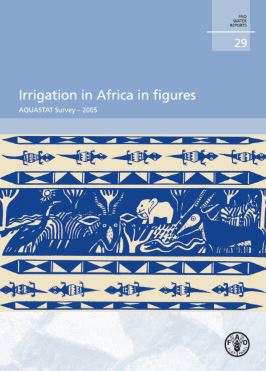
Irrigation in Africa in figures: AQUASTAT Survey - 2005
Water Report 29 - 2005; (french)
This report presents the results of the survey carried out in the 53 countries of Africa during 2004-2005, and it analyses the changes that have occurred in the ten years since the first survey. Following the AQUASTAT methodology, the survey relied as much as possible on country-based statistics and information. A general summary presents a synopsis on water resources development, irrigation and drainage in the region. The CD-ROM accompanying the hard copy of the report contains detailed profiles on the situation in each country, while they are included in this digital version.
Review of world water resources by country
This report focuses on the work done through the AQUASTAT surveys to collect and analyse available information on water resources for all countries in the world. It introduces the concepts and methodology applied to compute country-level water resources data, and presents and analyses key findings at both global and regional levels. A summary table provides the elements of the water balance for each of the 170 countries and territories surveyed.
Agriculture, food and water - Contribution to World Water Development Report 1
Producing our daily food requires one thousand times more water than we use to drink and one hundred times more than we use to meet our basic personal needs. Agriculture is the major source of food and by far the largest consumer of water on the globe. What is the role of water in the world’s food production? What are the contributions to food production from rainfed and irrigated agriculture and from fisheries? How can more food be produced with the same amount of water? What role does the market play? How does food security connect to poverty and water use? This report discusses these and many other questions using up-to-date information and state-of-the-art knowledge.
Atlas of water resources and irrigation in Africa
Land and Water Digital Media Series 13 - 2001
This CD-ROM contains information on water resources and agricultural water use in Africa. The information is presented by river basin (major basin as well as sub-basins) and by country described in the country profiles, tables, geographical data layers, and a database of African dams.
Irrigation in Latin America and the Caribbean in figures
Water Report 20 - 2000 (english and spanish)
This report presents the results of the AQUASTAT survey for 32 countries inf the Latin America and the Caribbean, carried out in 1999. The survey relied as much as possible on country-based statistics and information contained in national strategy papers. A general summary presents a regional analysis of water resources, irrigation and drainage in the region, and a series of country profiles describes the situation in each country more in detail.
Irrigation in Asia in figures
This report presents the results of the AQUASTAT survey performed in 21 countries in Asia in 1997 and 1998, relying as much as possible on country-based statistics and information contained in national publications. A general summary presents a synopsis on water resources development, irrigation and drainage in the region, and country profiles describe the specific situation of each country.
Water resources of the Near East region: a review
In order to provide a rational analysis for the discussion on increasing water scarcity and potential for irrigation expansion in the Near East, AQUASTAT compiled existing information on the water resources of the Region. Similar to a previous study on water resources of African countries, undertaken in 1995, this survey is based essentially on country-based statistics and information contained in sector studies and master plans. Due account has been taken of the interaction of groundwater and surface water and the problem of transboundary flows.
Irrigation in the Countries of the Former Soviet Union in figures
This report presents the results of a survey on water and agriculture for the 15 countries of the Former Soviet Union, carried out in 1996 and 1997. The survey relied as much as possible on country-based statistics and information contained in national strategy papers. A general summary presents a regional analysis of water resources, irrigation and drainage in the region, and a series of country profiles describes the situation in each country more in detail. A section presents the specific problems related to water management in the Aral Sea basin.
Irrigation potential in Africa: A basin approach
FAO Land and Water. Bulletin 4 - 1997
Assessment of irrigation potential in Africa is of prime importance for planning of sustainable food production on the continent. This study combines a review of existing information on irrigation potential by country with an approach using a geographic information system to assess land and water availability for irrigation on the basis of river basins. The results of this study and the methodology developed in the report should be useful to researchers and planners at national and regional levels working to achieve sustainable water resources development in Africa.
Irrigation in the Near East region in figures
This report presents the results of a survey on water and agriculture for 29 countries in the Near East region taken in 1995 and 1996. The survey relied mostly on country-based statistics and information contained in sector studies and master plans. A general summary presents a regional analysis of water resources and irrigation in the region, and 29 country profiles describe the situation in each country more in detail.
Irrigation in Africa in figures - 1995
This report presents the results of a survey on water and agriculture in Africa taken between October 1994 and April 1995. The survey relied mostly on country-based statistics and information contained in sector studies and master plans. A general summary presents a regional analysis of water resources and irrigation in Africa, and 53 country profiles describe the situation in each country more in detail.
Water resources of African countries: a review
In order to provide a rational basis for the discussion on increasing water scarcity and the potential for irrigation expansion in Africa, AQUASTAT compiled existing information on the water resources of the African continent. Contrary to previous attempts, this survey is based essentially on country-based statistics and information contained in sector studies and master plans. Due account has been taken of the interaction of groundwater and surface water and the problem of transboundary flows.